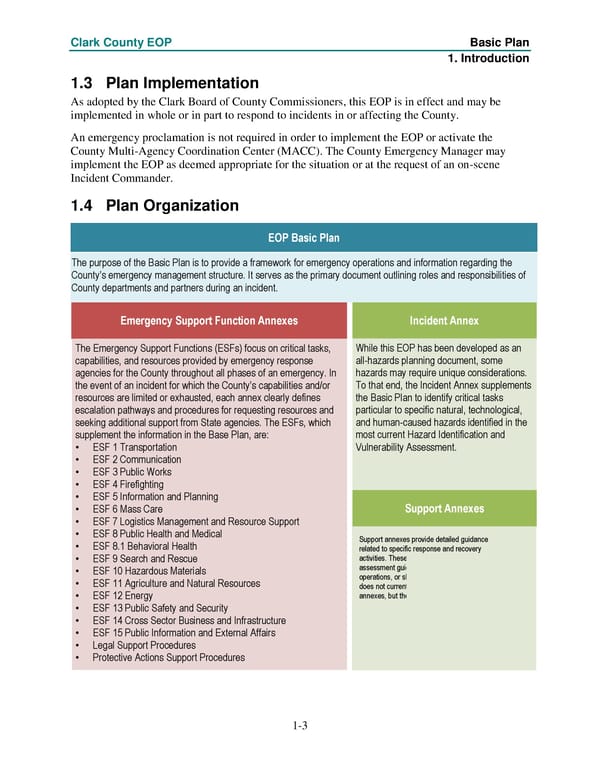Clark County EOP Basic Plan 1. Introduction 1.3 Plan Implementation As adopted by the Clark Board of County Commissioners, this EOP is in effect and may be implemented in whole or in part to respond to incidents in or affecting the County. An emergency proclamation is not required in order to implement the EOP or activate the County Multi-Agency Coordination Center (MACC). The County Emergency Manager may implement the EOP as deemed appropriate for the situation or at the request of an on-scene Incident Commander. 1.4 Plan Organization EOP Basic Plan The purpose of the Basic Plan is to provide a framework for emergency operations and information regarding the County’s emergency management structure. It serves as the primary document outlining roles and responsibilities of County departments and partners during an incident. Emergency Support Function Annexes Incident Annex The Emergency Support Functions (ESFs) focus on critical tasks, While this EOP has been developed as an capabilities, and resources provided by emergency response all-hazards planning document, some agencies for the County throughout all phases of an emergency. In hazards may require unique considerations. the event of an incident for which the County’s capabilities and/or To that end, the Incident Annex supplements resources are limited or exhausted, each annex clearly defines the Basic Plan to identify critical tasks escalation pathways and procedures for requesting resources and particular to specific natural, technological, seeking additional support from State agencies. The ESFs, which and human-caused hazards identified in the supplement the information in the Base Plan, are: most current Hazard Identification and • ESF 1 Transportation Vulnerability Assessment. • ESF 2 Communication • ESF 3 Public Works • ESF 4 Firefighting • ESF 5 Information and Planning Support Annexes • ESF 6 Mass Care • ESF 7 Logistics Management and Resource Support • ESF 8 Public Health and Medical Support annexes provide detailed guidance • ESF 8.1 Behavioral Health related to specific response and recovery • ESF 9 Search and Rescue activities. These may include damage • ESF 10 Hazardous Materials assessment guidelines, debris management • ESF 11 Agriculture and Natural Resources operations, or shelter plans. The County does not currently maintain Support • ESF 12 Energy annexes, but these may be added at a later • ESF 13 Public Safety and Security date. • ESF 14 Cross Sector Business and Infrastructure • ESF 15 Public Information and External Affairs • Legal Support Procedures • Protective Actions Support Procedures 1-3
 Emergency Operations Plan Page 20 Page 22
Emergency Operations Plan Page 20 Page 22